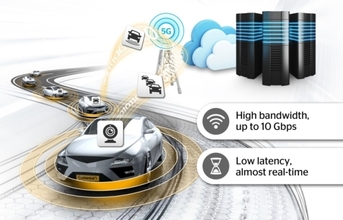
Making the 5G cellular potential visible
Practically all major automotive trends involve connectivity: greater driving safety is not only based upon sensor networks in the car and networked sensor signal interpretation but also on additional information from outside the car. Improving the efficiency of driving will increasingly require predictive driving strategies which factor in data from a backend via the cloud and from other vehicles.
Automated driving as an important step towards accident-free driving (vision zero) is hardly conceivable without the electronic horizon (eHorizon) which integrates digital map data with sensor data for up-to-date maps and real-time traffic information. "The latest available data is the fuel of connected vehicles", said Robert Gee, Head of Product Management, Software & Connected Solutions and Telematics Systems Engineering Manager, Japan at Continental. "As vehicles gain an equal footing in the Internet of Everything, data traffic will expand dramatically. Current cellular standards are not prepared for this. 5G, however, is." The 5G technology targets to provide up to a million connections per square kilometer, allowing for many more devices than 4G.
During the Yokohama and Tokyo tech shows Continental demonstrates the technical potential of 5G: With their high-bandwidth prototype of a 5G system Continental and NTT DOCOMO are able to set up a high-resolution video-chat connection between their booths on both shows.
"The new cellular standard 5G will be able to connect vehicles with other road users and the infrastructure in ways beyond your imagination", Gee said. With a targeted 10 gigabits per second (Gbps) for downlink speeds and drastically reduced latency times which may be as low as 1 millisecond (1 msec) in a wireless link, exciting new use cases and services are becoming within reach. Among these are high density platooning, HD (high definition) live map updates, and sensor sharing.
A key potential of 5G cellular lies in its low latency times. This speed of response can be used for V2X communication. Once latency times are significantly reduced, wireless communication between cars, with the infrastructure and with other road users can improve the data basis for driver assistance and automated driving. "To make all this possible we need to look into frequency and data propagation details now", Gee said. "That is why our current roadmap includes research into antenna and questions such as which frequencies are most suitable for moving vehicles."
END


























